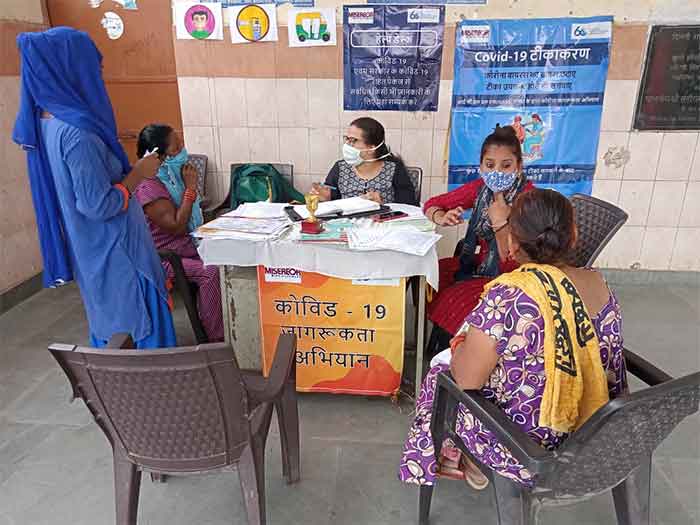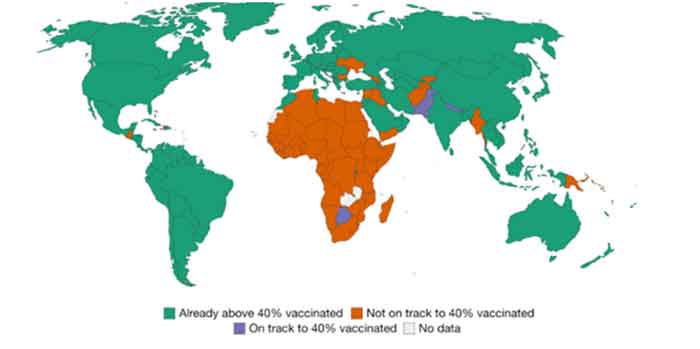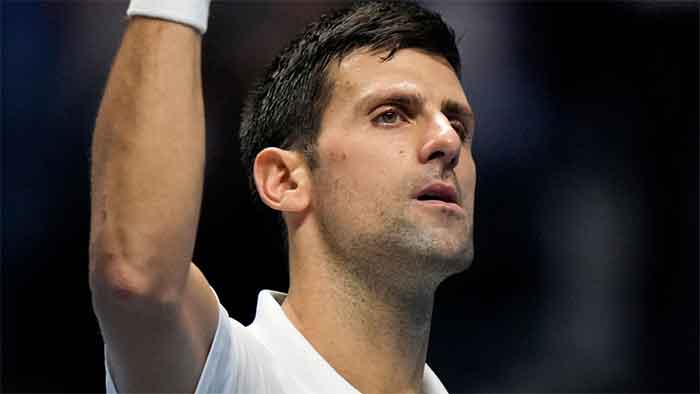
On 21 October 2021, India crossed its milestone of administering over 1 billion (100 crores) doses within 278 days since it began the vaccination rollout (on 16th January 2021).
The World Health Organization (WHO) calls upon all countries to ensure that at least 70% of their population must be fully vaccinated by June 2022. India aims to cross 70% goalpost by end of this year – which is indeed a welcome commitment. Currently, over 20% of India’s population is fully vaccinated. As vaccination began in January 2021, it is really a compelling public health priority for India to fully vaccinate over 70% of population at the earliest, before protection may begin to decline for some of those who got the jab first.
Vaccination in some other countries is also happening at commendable pace. Countries like Singapore that had first fully vaccinated over 80% of its people earlier this year, China had administered over 2.3 billion doses, countries in North America and Europe had fully vaccinated 50% to 80% (or more) of its population and even begun rollout of booster doses despite the WHO cautioning against it.
Renowned infectious diseases expert Dr Ishwar Gilada who is also the Secretary General of Organised Medicine Academic Guild (OMAG) said that “No doubt, crossing 1 billion vaccine doses is a real festival for India, but mind well, we are half way through for reaching the hypothetical figure of 70% of population being fully vaccinated for attaining herd immunity. India has a population of almost 1.4 billion, so we need 2.8 billion doses to vaccinate everyone.”
“Currently India is aiming to vaccinate all eligible people above 18 years of age (940 million). A recent decision was made to vaccinate those in 12-17 years age group which is additional 170 million eligible people. So now, to fully vaccinate all eligible people above age 12, we will need to administer 2.22 billion doses. While it is commendable for India to cross 1 billion dose administration landmark, we need to accelerate the pace to administer the remaining 1.22 billion within a limited time-period” added Dr Ishwar Gilada, who is also the President of AIDS Society of India (ASI) and elected to the Governing Council of International AIDS Society (IAS).
Call to fully rollout all approved vaccines on scale
Dr Suneela Garg, President of Organised Medicine Academic Guild (OMAG) joins Dr Gilada in appealing to government of India to fully rollout all approved vaccines in the country. Currently, only three out of six vaccines have been rolled out, and only one out of these three rolled out vaccines, accounts for majority of the doses administered. “All (99.9%) of the vaccine doses administered in India are domestically manufactured within the nation with Covishield (Oxford AstraZeneca) accounting for maximum doses administered (89%). Then, about 11% doses administered are of Covaxin and a very small number of Sputnik V, have also been administered” said Dr Suneela Garg.
We have to ensure not only the production and rollout of all six vaccines approved in India but also have to expand the scale at which these are produced, rolled out and administered, as well as, exported. “Doing so, will also help India have a much bigger stock of Covid vaccines for its “Vaccine Maitri” programme to help other nations. That will also generate foreign capital via exports for our domestic manufacturers. India has approved these six vaccines so far: Covishield (made by Serum Institute of India), Covaxin (made by Bharath Biotech), Sputnik, Moderna (licensed to Cipla for marketing), Johnson & Johnson single dose vaccine (licensed to Biological-E for domestic production) and ZyCovD (made by Zydus Cadila). Out of these six approved vaccines in India, Moderna, J&J and ZyCovD are yet to make a debut” informed Dr Suneela Garg.
Commendable vaccination in India but not uniform
India’s vaccination rollout has been commendable given the realities of health systems and diversities that exist within the nation (and states), however, it is not uniform. “If we look at data, India has administered increasingly more doses every month since January 2021 (but it declined during 1-18 October 2021), and that too overcoming initial high degree of vaccine hesitancy. It is important to note that daily vaccination rate is also not uniform with some days witnessing the vaccination rate spiking up many times more than the average rate. These are important lessons learnt and will inform the next leg of the journey towards fully vaccinating all eligible people in the country” said Dr Ishwar Gilada.
Average vaccine doses administered per day in May 2021 in India was 19.69 lakh (1.969 million) doses daily, in June 2021 the average rose to 39.89 lakhs (3.989 million) doses daily, in July 2021 the average further went up to 43.41 lakhs (4.341 million) doses daily, in August 2021 the average doses per day reached 59.29 lakhs (5.929 million), in September 2021 the average daily doses went further up to 78.69 lakhs (7.869 million), but in first 18 days of October 2021, the average doses administered daily fell to 53.21 lakhs (5.321 million). It is important to note that the goal was to vaccinate 1 crore (10 million) every day to reach the target.
Dr Gilada reminds that “Time is of prime essence because all eligible people should be fully vaccinated worldwide within limited time duration. Though the WHO is aiming for all countries to fully vaccinate 70% of their population by June 2022, India plans to do that in next 70 days (by end of 2021) and the speed choosen is administering 2 crore (20 million) vaccine-doses per day.”
On behalf of Organised Medicine Academic Guild, Dr Ishwar Gilada and Dr Suneela Garg recommended:
* As most at-risk people (healthcare and other frontline workers, senior citizens) were first vaccinated in January-February 2021, India should go by science-backed mandate to administer booster doses to those whose vaccine-protection might be declining, in early 2022. While we protect others it is also important to ensure that those fully vaccinated remain protected as well. This is our best shot to eventually hope that herd immunity will work leaving Covid behind us.
* Progress within the country has also been uneven. Some states like Himachal Pradesh and Sikkim are the best performing ones whereas some states like Uttar Pradesh, Bihar, Jharkhand are lagging behind with lower rate of either single-dose or fully vaccinated people in their population (than the average national single-dose rate of 51% and fully vaccination rate of 20% of population).
* In light of scientific evidence and public health rationale, India should reduce the gap between two doses of Covishield. This will help us accelerate progress as well as help more people to be fully protected earlier. Also we need to overcome gender gap, prioritise women.
* Although India has allocated 25% vaccines quota for private sector, the rollout of vaccination in private sector is much smaller than 25% compared to overall doses administered in India. We need to fully engage private healthcare infrastructure and catalyze progress towards fully vaccinating all the people.
* Vaccination should happen round the clock, may be in two shifts of total 16 hours, 8 am till midnight. It should be available all days of the week, irrespective of holidays. On public holidays, they should work overtime with higher workforce. Mobile vaccination vans should come handy.
* The Drug Controller General of India (DCGI) should quickly review phase-3 data of the available vaccines to issue a regular license for the tested ones, rather than continuing their Emergency Use Authorisation (EUA) mode.
Covid vaccines approved by the WHO and credible health science regulators have shown to protect fully vaccinated people by significantly reducing the likelihood of them developing any serious outcome if they get infected with corona virus. Like many other vaccines, protection is extremely significant, though not absolute (so those who are fully vaccinated should continue to practice safe methods to reduce the risk of contracting the virus). In countries where large part of the population is fully vaccinated, rate of hospitalisation, intensive care unit admissions, ventilators etc or deaths related to Covid-19 has sharply declined. This stands out in contrast with countries where vaccination rate is low and rate of Covid-related serious outcomes is directly proportional to the number of people who are getting infected. Let’s hope that significant part of our global population gets fully vaccinated within the time duration and the pandemic becomes a past.
Bobby Ramakant is a World Health Organization (WHO) Director General’s WNTD Awardee and part of CNS (Citizen News Service) and Asha Parivar teams. Follow him on Twitter @BobbyRamakant or visit www.bit.ly/BobbyRamakant
– Shared under Creative Commons (CC)












































